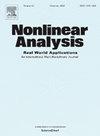Junction in a thin multi-domain for nonsimple grade two materials in BH
IF 1.8
3区 数学
Q1 MATHEMATICS, APPLIED
引用次数: 0
Abstract
We consider a thin multi-domain in , with , consisting of a vertical rod on top of a horizontal disk made of non-simple grade-two materials or multiphase ones. In this thin multi-domain, we consider a classical hyperelastic energy and complement it by adding an interfacial energy with a bulk density of the kind , where is a continuous function with linear growth at and denotes the Hessian tensor of a vector-valued function that represents a deformation of the multi-domain. Considering suitable boundary conditions on the admissible deformations and assuming that the two volumes tend to zero at the same rate, we prove that the limit model is well posed in the union of the limit domains, with dimensions 1 and , respectively, and its limiting energy keeps memory of the original full dimensional trace constraints in a more accurate way than previous related models in the literature. Moreover, we show that the limit problem is uncoupled if , and “partially” coupled if .
求助全文
约1分钟内获得全文
求助全文
来源期刊
CiteScore
3.80
自引率
5.00%
发文量
176
审稿时长
59 days
期刊介绍:
Nonlinear Analysis: Real World Applications welcomes all research articles of the highest quality with special emphasis on applying techniques of nonlinear analysis to model and to treat nonlinear phenomena with which nature confronts us. Coverage of applications includes any branch of science and technology such as solid and fluid mechanics, material science, mathematical biology and chemistry, control theory, and inverse problems.
The aim of Nonlinear Analysis: Real World Applications is to publish articles which are predominantly devoted to employing methods and techniques from analysis, including partial differential equations, functional analysis, dynamical systems and evolution equations, calculus of variations, and bifurcations theory.

 求助内容:
求助内容: 应助结果提醒方式:
应助结果提醒方式:


